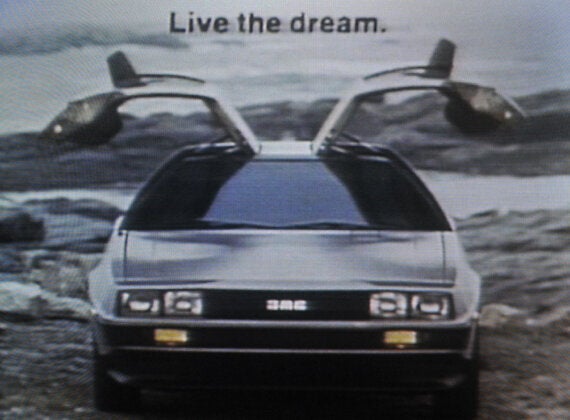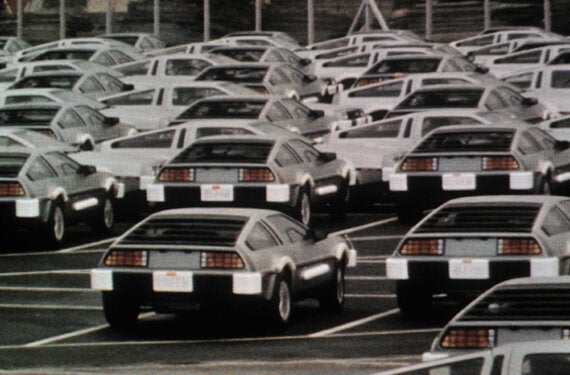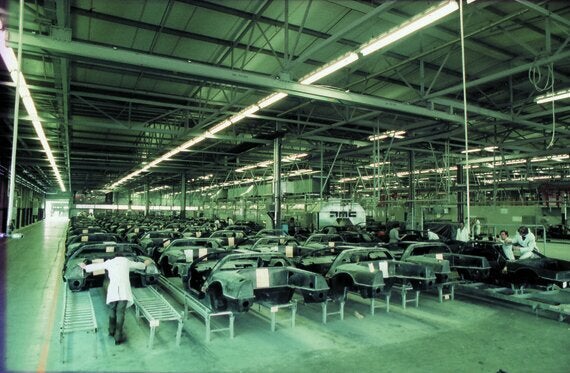It is five years now since Duncan Campbell's Make it New John rolled off the production line. Pristine and gleaming in its 2009 plates, Campbell's film was very much that year's model. Turbo-charged (in its hurry to go beyond documentary conventions and restrictions), but bio-fuelled (in its focus on individual, personal stories), the piece was a new type of all-purpose hybrid, with a conceptual va-va-voom that was underscored by a surprisingly raw emotional power.

The John of the title is, ostensibly, John DeLorean - maverick genius automobile designer. As a leading light in the creative team at post-war General Motors, DeLorean had been responsible for a succession of ever-more eye-catching new models - their innovative lines, unprecedented performance and rapid turnover encapsulating the allure (and the ephemeral, disposable nature) of the American dream. DeLorean's decision to go out on his own and start his own company seemed simply to be the next smooth, logical gear-change in that upwards-and-onwards progression - one that appeared to have reached its iconic apotheosis in the shape of the audacious 'gull-winged' DMC 12 coupé. Advertised as the futuristic dream car for an upwardly mobile mass-market, the 'DeLorean' (as it became more commonly known) was also a vehicle for a much larger set of aspirations; especially after the British government invested heavily in DeLorean's magic touch, in the misplaced hope that siting a factory in Belfast might jump-start an economic revival, bridge the sectarian divide, even ameliorate the violent conflict of the Troubles.
The dream was so enticing that no-one wanted to look under the bonnet. Just as the DMC's looks were badly let down by substandard engineering, DeLorean's ambitions were undermined by shaky finance, with underwhelming sales and precarious loans leading the Thatcher administration to withdraw the escalating subsidy first pledged by the previous Labour government, forcing both the plant and the business to close. By the end, DeLorean the new-model guru and business saviour was looking more like a used-car salesman; his patter seductive, his word not to be trusted.

The DMC 12 has lived on, though, in different ways. In vintage-car circles, remaining examples continue to change hands at eye-watering prices. The car's popularity, and cult appeal, had already been boosted by its drive-on part as the Tardis-like transit vehicle in the time-travel movie, Back to the Future. Campbell makes no direct reference to the Michael J Fox blockbuster in his film - although, intriguingly, at the beginning of Make it New John, puts his own clock back also to the 1950s, to a time when the future was one of unalloyed promise, and before the yearning that propels the American dream-life found ever-greater surrogate satisfaction in the world of consumer products. The road to and from that halcyon, smalltown point-of-departure starts out quiet but is quickly crowded by cars: big cars, fast cars, brash cars, new cars; cars with the roof down and music playing; cars as markers of status, and as symbols of something elusive, intangible.
Campbell conjures that carnivalesque procession of cars down the decades from various public and online archives. As the pile-up of footage echoes the pile-up of vehicles, he reminds us, obliquely, how our contemporary traffic in images has become as crowded and chaotic as the traffic on the roads. The skill with which Campbell combines these disparate filmic fragments brings another analogy to mind. Although we still crave new images, and new experiences, their value often plummets the minute we obtain them, just as a new car does the moment it leaves the showroom. Increasingly now, it is old stuff we tend to treasure, and which continues to hold its worth. When all is said and done, though, with images, as with motor vehicles, there are no failsafe guarantees. Not everything second-hand is time-aged and time-proof; not everything used is vintage. It still takes an eye like Campbell's to sort out the classic from the scrap.
Following its freewheeling extended prelude, Make it New John details the Belfast phase of the larger DeLorean story in a more straightforward arrangement of TV and newsreel clips that take us from the euphoria of the initial announcement, and the first cars being built, through the growing rumbles of financial and political discontent, to the final wind-down, and the occupation of the factory by some of its workers. The film then shifts again, into a haunting, protracted coda, which, despite its carefully evoked period texture, is self-evidently a staged reconstruction of a TV interview with members of that sit-in. It is here that we are introduced to another protagonist named John, who may just as easily be the one of the title: an elderly factory worker, who had greeted the arrival of the plant as his one big chance to start over, and who now feels correspondingly betrayed.

Almost half a century on, Belfast has seen a major economic revival, and has changed dramatically from the place it was in the late 1970s. and early 80s. There is no trace of the DeLorean factory, although there is a Museum to the Titanic, another ill-starred venture that began there. Northern Ireland's recent upturn has been built on many things, but, among the reasons cited, it was curious to see a significant rise in tourism apparently generated by people flocking to visit the locations used in the TV series, Game of Thrones. A prime example of the kind of 'fantasy history' viewers now seem to favour over period-accurate recreation, its customised, pimped-up combo of disparate elements from unconnected eras is so deliriously scrambled it makes a piece of pop retro sci-fi like Back to the Future seem positively innocent. In our post-industrial, post-Fordist times, it's strangely appropriate perhaps that Northern Ireland's fortunes have been raised anew, not by the material promise of a futuristic dream car but by a another time-travelling vehicle, and a different kind of fantasy.